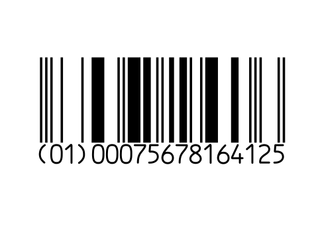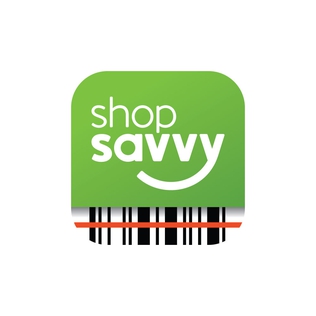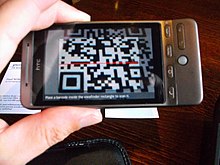
A barcode or bar code is a method of representing data in a visual, machine-readable form. Initially, barcodes represented data by varying the widths, spacings and sizes of parallel lines. These barcodes, now commonly referred to as linear or one-dimensional (1D), can be scanned by special optical scanners, called barcode readers, of which there are several types. Later, two-dimensional (2D) variants were developed, using rectangles, dots, hexagons and other patterns, called matrix codes or 2D barcodes, although they do not use bars as such. 2D barcodes can be read using purpose-built 2D optical scanners, which exist in a few different forms. 2D barcodes can also be read by a digital camera connected to a microcomputer running software that takes a photographic image of the barcode and analyzes the image to deconstruct and decode the 2D barcode. A mobile device with a built-in camera, such as a smartphone, can function as the latter type of 2D barcode reader using specialized application software.

A barcode reader or barcode scanner is an optical scanner that can read printed barcodes, decode the data contained in the barcode to a computer. Like a flatbed scanner, it consists of a light source, a lens and a light sensor for translating optical impulses into electrical signals. Additionally, nearly all barcode readers contain decoder circuitry that can analyse the barcode's image data provided by the sensor and send the barcode's content to the scanner's output port.

An image scanner—often abbreviated to just scanner—is a device that optically scans images, printed text, handwriting or an object and converts it to a digital image. Commonly used in offices are variations of the desktop flatbed scanner where the document is placed on a glass window for scanning. Hand-held scanners, where the device is moved by hand, have evolved from text scanning "wands" to 3D scanners used for industrial design, reverse engineering, test and measurement, orthotics, gaming and other applications. Mechanically driven scanners that move the document are typically used for large-format documents, where a flatbed design would be impractical.

PDF417 is a stacked linear barcode format used in a variety of applications such as transport, identification cards, and inventory management. "PDF" stands for Portable Data File. The "417" signifies that each pattern in the code consists of 4 bars and spaces in a pattern that is 17 units (modules) long. The PDF417 symbology was invented by Dr. Ynjiun P. Wang at Symbol Technologies in 1991. It is defined in ISO 15438.

Code 128 is a high-density linear barcode symbology defined in ISO/IEC 15417:2007. It is used for alphanumeric or numeric-only barcodes. It can encode all 128 characters of ASCII and, by use of an extension symbol (FNC4), the Latin-1 characters defined in ISO/IEC 8859-1.. It generally results in more compact barcodes compared to other methods like Code 39, especially when the texts contain mostly digits. Code 128 was developed by the Computer Identics Corporation in 1981.

A QR code is a type of two-dimensional matrix barcode, invented in 1994, by Japanese company Denso Wave for labelling automobile parts. A QR code consists of black squares arranged in a square grid on a white background, including some fiducial markers, which can be read by an imaging device, such as a camera, and processed using Reed–Solomon error correction until the image can be appropriately interpreted. The required data are then extracted from patterns that are present in both the horizontal and the vertical components of the QR image.
Automatic identification and data capture (AIDC) refers to the methods of automatically identifying objects, collecting data about them, and entering them directly into computer systems, without human involvement. Technologies typically considered as part of AIDC include QR codes, bar codes, radio frequency identification (RFID), biometrics, magnetic stripes, optical character recognition (OCR), smart cards, and voice recognition. AIDC is also commonly referred to as "Automatic Identification", "Auto-ID" and "Automatic Data Capture".

A Data Matrix is a two-dimensional code consisting of black and white "cells" or dots arranged in either a square or rectangular pattern, also known as a matrix. The information to be encoded can be text or numeric data. Usual data size is from a few bytes up to 1556 bytes. The length of the encoded data depends on the number of cells in the matrix. Error correction codes are often used to increase reliability: even if one or more cells are damaged so it is unreadable, the message can still be read. A Data Matrix symbol can store up to 2,335 alphanumeric characters.
The Global Trade Item Number (GTIN) is an identifier for trade items, developed by the international organization GS1. Such identifiers are used to look up product information in a database which may belong to a retailer, manufacturer, collector, researcher, or other entity. The uniqueness and universality of the identifier is useful in establishing which product in one database corresponds to which product in another database, especially across organizational boundaries.
A guard tour patrol system is a system for logging the rounds of employees in a variety of situations such as security guards patrolling property, technicians monitoring climate-controlled environments, and correctional officers checking prisoner living areas. It helps ensure that the employee makes their appointed rounds at the correct intervals and can offer a record for legal or insurance reasons. Such systems have existed for many years using mechanical watchclock-based systems. Computerized systems were first introduced in Europe in the early 1980s, and in North America in 1986. Modern systems are based on handheld data loggers and RFID sensors. The system provides a means to record the time when the employee reaches certain points on their tour. Checkpoints or watchstations are commonly placed at the extreme ends of the tour route and at critical points such as vaults, specimen refrigerators, vital equipment, and access points. Some systems are set so that the interval between stations is timed so if the employee fails to reach each point within a set time, other staff are dispatched to ensure the employee's well-being. An example of a modern set-up might work as follows: the employee carries a portable electronic sensor (PES) or electronic data collector which is activated at each checkpoint. Checkpoints can consist of iButton semiconductors, magnetic strips, proximity microchips such as RFIDs or NFC- or optical barcodes. The data collector stores the serial number of the checkpoint with the date and time. Later, the information is downloaded from the collector into a computer where the checkpoint's serial number will have an assigned location. Data collectors can also be programmed to ignore duplicate checkpoint activations that occur sequentially or within a certain time period. Computer software used to compile the data from the collector can print out summaries that pinpoint missed checkpoints or patrols without the operator having to review all the data collected. Because devices can be subject to misuse, some have built-in microwave, g-force, and voltage detection.

High Capacity Color Barcode (HCCB) is a technology developed by Microsoft for encoding data in a 2D "barcode" using clusters of colored triangles instead of the square pixels conventionally associated with 2D barcodes or QR codes. Data density is increased by using a palette of 4 or 8 colors for the triangles, although HCCB also permits the use of black and white when necessary. It has been licensed by the ISAN International Agency for use in its International Standard Audiovisual Number standard, and serves as the basis for the Microsoft Tag mobile tagging application.
Mobile tagging is the process of providing data read from tags for display on mobile devices, commonly encoded in a two-dimensional barcode, using the camera of a camera phone as the reader device. The contents of the tag code is usually a URL for information addressed and accessible through Internet.

The GS1 Databar Coupon code has been in use in retail industry since the mid-1980s. At first, it was a UPC with system ID 5. Since UPCs cannot hold more than 12 digits, it required another bar code to hold additional information like offer code, expiration date and household ID numbers. Therefore, the code was often extended with an additional UCC/EAN 128 bar code. EAN 13 was sometimes used instead of UPC, and because it starts with 99, it was called the EAN 99 coupon barcode, and subsequently GS1 DataBar. After more than 20 years in use, there is now a need to encode more data for complex coupons, and to accommodate longer company IDs, so the traditional coupon code has become less efficient and sometimes not usable at all.

A SPARQCode is a matrix code encoding standard that is based on the physical QR Code definition created by Japanese corporation Denso-Wave.
Springpad was a free online application and web service that allowed its registered users to save, organize and share collected ideas and information. As users added content to their Springpad accounts, the application automatically identified and categorized it, then generated additional snippets based on the types of objects added—for example, listing price comparisons for products and showtimes for movies.

ShopSavvy is a mobile application for shopping that scans products and finds online and local stores providing those products. Additionally, ShopSavvy compares the prices, displays user reviews, and searches for deals and discounts on scanned items. The app was developed by Rylan Barnes, Jason Hudgins and Alexander Muse, who won the “Google’s Android Developer Challenge" and subsequently founded ShopSavvy, Inc.

Screen-Smart Device Interaction (SSI) is fairly new technology developed as a sub-branch of Digital Signage.

Scan is a mobile app development company headquartered in Provo, Utah, United States. The company was founded in January 2011 by Garrett Gee together with his college friends Ben Turley and Kirk Ouimet. The company, owned and operated by Scan, Inc, was acquired by Snapchat in 2014 for $54 million.
Barcode library or Barcode SDK is a software library that can be used to add barcode features to desktop, web, mobile or embedded applications. Barcode library presents sets of subroutines or objects which allow to create barcode images and put them on surfaces or recognize machine-encoded text / data from scanned or captured by camera images with embedded barcodes. The library can support two modes: generation and recognition mode, some libraries support barcode reading and writing in the same way, but some libraries support only one mode.
Scandit AG, commonly referred to as Scandit, is a Swiss technology company that provides smart data capture software. Their technology allows any smart device equipped with a camera to scan barcodes, IDs and text and to perform additional functions using augmented reality and advanced analytics.













